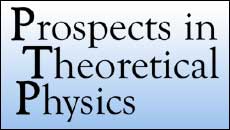|
2007 Program |
|
SUGGESTED BACKGROUND READING FOR THE PiTP PROGRAM "The Standard Model and Beyond":
1) "The Pink Book" - QCD and Collider Physics, R.K. Ellis, W.J. Stirling and B.R. Webber (Cambridge University Press, 1996), especially Chapters 2 through 7; 2) My five lectures from TSI 2006 available at http://www.phys.washington.edu/users/ellis/TSI%20July%2006.htm (you are encouraged to try the HW): 3) The recent "Primer for LHC Physics" by J.M. Campbell, J.W. Huston, W.J. Stirling, hep-ph/0611148v1; 4) Relevant lectures/notes by G. Sterman, et al., hep-ph/0412013v1, hep-ph/0409313v1. As background for the lectures presented by PAUL LANGACKER: A concise summary of the standard model can be found in hep-ph/0304186 and a set of lecture slides on testing the standard model can be found at http://boudin.fnal.gov/AcLec/AcLecLang.html These documents also contain additional references participants may find helpful. As background for the lectures presented by YOSEF NIR:
As background for the lectures presented by ANEESH MANOHAR: You will find a useful bibiography on the Standard Model at LHC and Professor Peskin's lecture notes on this topic at http://www.slac.stanford.edu/~mpeskin/Physics450/ As background reading for the lectures presented by NATHAN SEIBERG: Please see "Lectures on Supersymmetry Breaking" hep-ph/0702069 As background reading for the lectures presented by MICHAEL DINE, MARKUS LUTY and SCOTT THOMAS on supersymmetry: Students may want to look at either or both of the two reviews: Steve Martin, A Supersymmetry Primer hep-ph/9709356 and M. Dine, Supersymmetry Phenomenology with a Broad Brush hep-ph/9612389There are also a number of recent books which cover much of the necessary background material. Students need not rush out to buy these, but if they own them, they might want to read the chapters introducing supersymmetry, supersymmetry breaking, and introducing the MSSM. They may also find useful introductory material on supersymmetry dynamics. 1) Supersymmetry and supergravity. By Julius Wess, Jonathan Bagger. 1992. Series: Princeton Series in Physics http://www.slac.stanford.edu/spires/find/books/www?key=304549 2) Theory and phenomenology of sparticles: An Account of four - dimensional N = 1 supersymmetry in high energy phys. By Manuel Drees, Rohini Godbole, Probir Roy. 2004. http://www.slac.stanford.edu/spires/find/books/www?key=296279 3) Weak scale supersymmetry: From superfields to scattering events. By Howard Baer, Xerxes Tata. 2006. http://www.slac.stanford.edu/spires/find/books/www?key=348813 4) Modern sypersymetry: Dynamics and duality. By John Terning. 2006. Series: International Series of Monographs on Physics, Vol. 132 http://www.slac.stanford.edu/spires/find/books/www?key=348864 5) Supersymmetry and string theory: Beyond the standard model. By Michael Dine. 2007. http://www.slac.stanford.edu/spires/find/books/www?key=349186 Additional
background reading suggestions will be posted as they are provided by
the lecturers, so please check back periodically for new information. (This page was last updated with new information on July 6, 2007) |
|
